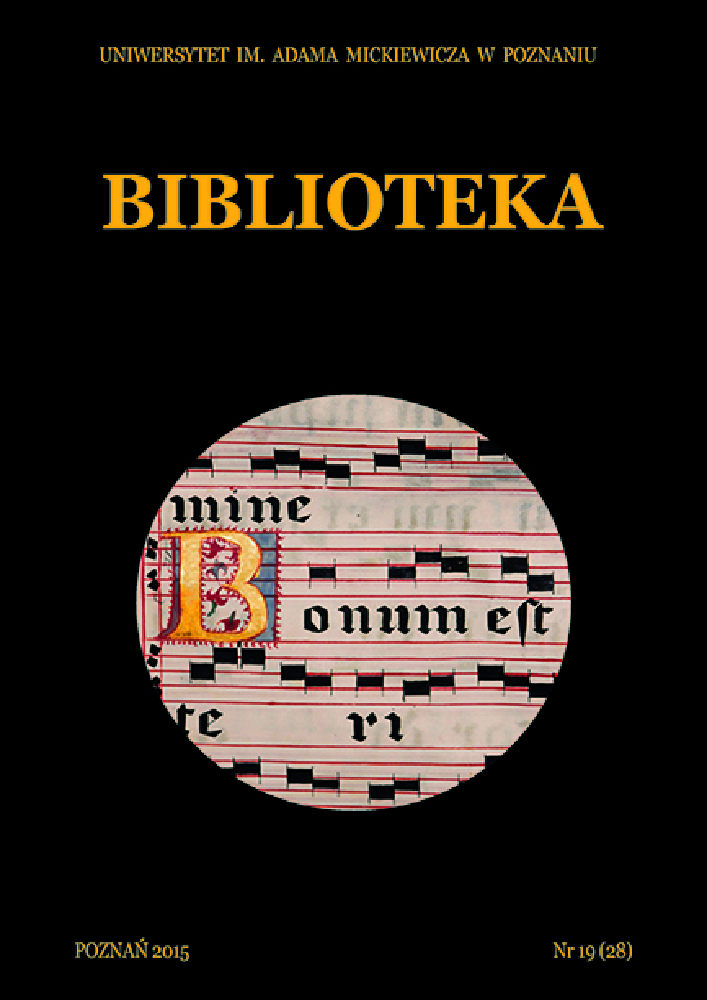Abstract
The article summarises the results of a query carried out in the Archdiocese Archives in Gniezno during which five old prints bound in parchment sheets that undoubtedly come from one and the same manuscripts were found. In addition, another query in the font MS “Fragmenty” surfaced the existence of yet two more pages (sheets) from the same manuscript that had been already taken out from the bindings. The codicological and paleographical analyses of the remains of the manuscript show that it must have originated in a Cistercian scriptorium at the end of the twelfth century. The content of the surviving seven sections indicates that they were part of a large-sized collection of homilies (de tempore, pars aestivalis). The four old prints with their bindings including the sheets from the manuscript were once kept at the former library of the Cistercian monastery in Wągrowiec. In conclusion then, it can be stated with a great deal of confidence that the manuscript itself, whose pages had been used for the bindings of the books, must have been included in the collection of the monastery’s library. The resulting conclusion is that the parchment fragments found in the bindings of the Wągrowiec old prints must be remnants of the oldest known manuscript codex from the old Łekno-Wągrowiec abbey.References
Bischoff B., Paläographie des römischen Altertums und des abendländischen Mittelalters, Berlin 1979.
Byczkowska-Sztaba J., Nieznane fragmenty liturgiku muzycznego na oprawie Kroniki wągrowieckiej, „Studia i Materiały do dziejów Pałuk” 2003, t. 4, s. 153–178.
Derolez A., The Palaeography of Gothic Manuscript Books. From the Twelfth to the Early Sixteenth Century, Cambridge 2008.
Estreicher K., Bibliografia polska, t. 26, Kraków 1915.
Gieysztor A., Zarys dziejów pisma łacińskiego, Warszawa 2009.
Grajkowska L., Biblioteka klasztorna cystersów w Wągrowcu, „Studia Gnesnensia” 1981, t. 6, s. 209–220.
Jażdżewski K.K., Biblia henrykowska IF 13 i Psałterz trzebnicki IF 440. Dzieła kaligraficzne cystersa lubiąskiego z lat 1238–1245, „Studia Źródłoznawcze” 1980, t. 25, s. 109–119.
Jażdżewski K.K., Dzieła kaligraficzne mnicha Jakuba, kopisty skryptorium cysterskiego w Lubiążu z pierwszej ćwierci XIII wieku, „Studia Źródłoznawcze” 1976, t. 21, s. 19–44.
Jażdżewski K.K., Litera e caudata w dokumentach. Przyczynek do dziejów ortografii i paleografii, „Studia Źródłoznawcze” 1978, t. 23, s. 40–52.
Jażdżewski K.K., Lubiąż. Losy i kultura umysłowa śląskiego opactwa cystersów (1163–1642), Wrocław 1992.
Ker N.R., From above top line to below top line: a Change into Scribal Practice, „Celtica” 1960, t. 5, s. 13–16.
Kwakkel E., Biting, kissing, and the Treatment of Feet: The Transitional script of the Long Twelfth Century, w: Studies in Medieval and Renaissance Book Culture. Turning Over a New Leaf: Change and Development in the Medieval Book, red. E. K wakkel, R. McKitterick, R. Thomson, Leiden 2012.
Lech S., Homiliarz, w: Encyklopedia katolicka, t. 6, red. J. Walkusz et al., Lublin 1993, kol. 1179–1180.
Palmer N.F., Simul Cantemus, Simul Pausemus. Zur mittelalterlichen Zisterzienserinterpunktion, w: Lesevorgänge. Prozesse des Erkennens in mittelalterlichen Texten, Bildern und Handschriften (Medienwandel – Medienwechsel – Medienwissen 11), red. E.C. Lutz, M. Backes, S. Matter, Zürich 2010, s. 483–728.
Parkes M.B., Pause and Effect: An Introduction to the history of Punctuation in the West, Aldershot 1992.
Patrologiae Cursus Completus. Series Latina, red. J.P. Migne, t. 1–217, Paris 1844–1855.
Petrucci A., Censimento dei codici dei secoli XI–XII. Instruzioni per la datazione, „Studi medievali” 1968, S. III , t. 9, s. 1115–1126.
Pokora P., Muraszko M., Skarby drukarstwa i introligatorstwa ze zbiorów dawnej Biblioteki Katedralnej w Gnieźnie. Katalog wystawy w Bibliotece Raczyńskich. Poznań, 5–30 maja 2015 r., Poznań 2015.
Powitz G., Datieren und Lokalisieren nach der Schrift, „Bibliothek und Wiessenschaft” 1976, t. 10, s. 124–139.
Réginald G., Homéliaires liturgiques médiévaux. Analyse de Manuscrits, Spoleto 1980.
Semkowicz W., Paleografia łacińska, Kraków 2011.
Wałkówski A., Skryptoria cystersów filiacji portyjskiej na Śląsku do końca XIII w.,Zielona Góra–Wrocław 1996.
Vezin J., La ponctuation du VIIIe au XIIe siècle, w: Mise en page et mise en texte du livre manuscrit, red. H.J. Martin, J. Vezin, Paris 1990.
License
Copyright (c) 2015 Jakub Łukaszewski

This work is licensed under a Creative Commons Attribution-ShareAlike 4.0 International License.
Utwory opublikowane w czasopiśmie Biblioteka, na platformie Pressto należącej do Uniwersytetu im. Adama Mickiewicza w Poznaniu od 2015 roku są udostępniane na
licencji Creative Commons Uznanie autorstwa-Na tych samych warunkach 4.0 Międzynarodowe.
Tym samym wszyscy zainteresowani są uprawnieni do korzystania z utworów opublikowanych po 2015 roku pod następującymi warunkami:
- uznania autorstwa czyli obowiązek podania wraz z rozpowszechnianym utworem informacji o autorstwie, tytule, źródle (odnośniki do oryginalnego utworu, doi) oraz samej licencji
- na tych samych warunkach — remiksując utwór, przetwarzając go lub tworząc na jego podstawie, należy swoje dzieło rozpowszechniać na tej samej licencji, co oryginał.
Uniwersytet im. Adama Mickiewicza w Poznaniu zachowuje prawo do czasopisma jako całości (układ, forma graficzna, tytuł, projekt okładki, logo itp.).
Autor zachowuje prawa majątkowe, ale udziela zgody Uniwersytetowi im. Adama Mickiewicza w Poznaniu na wykorzystanie dzieła. Autorzy tekstów zakwalifikowanych do publikacji proszeni są o wypełnienie podpisanie i przesłanie umowy.
Jeżeli autor artykułu nie jest przekonany, że może wykorzystywać cudze utwory (np. ilustracje, fotografie, tabele) w ramach cytatu we własnej tekście musi dostarczyć do redakcji czasopisma zgodę od uprawnionych podmiotów.
Prawa są zastrzeżone do wszystkich tekstów opublikowanych przed rokiem 2015.





